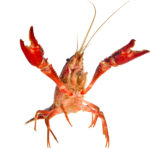Synthetic Hydrogel Material Mimics Lobster Underbelly’s Stretch and Strength
A team of researchers at MIT who were inspired by the underbelly of lobsters recently fabricated a new kind of hydrogel-based material that is strong, stretchy, and can withstand a remarkable amount of wear and tear. These researchers took inspiration from lobsters because of the impressive characteristics of the thin membrane that lines its underbelly, found to be “the toughest known hydrogel in nature”. The membrane is strong enough to protect the lobster from harm but also flexible enough that it can swim with ease.
To begin fabricating a prototype, the researchers used a process called electrospinning, which uses electric charges to create thin nanofiber threads out of polymer solutions. These tiny fibers were then welded together into a film that was tested for strength, stretchiness, and fatigue resistance. After testing, the researchers found that the new films they had created were “50 times more fatigue-resistant than the conventional nanofibrous hydrogels”.
After reading a study from another researcher that revealed that the lobster membranes were constructed from layers in a spiral pattern, the team accordingly made another prototype. This new film with the spiraled layers performed very similarly to the lobster membrane it was hoping to emulate: very strong and stretchy, while also incredibly fatigue-resistant. The material, if able to be scaled up properly, could eventually be used to create artificial tissues.
Learn about our two Decals!
 Click here to find out more about our Fall Bioinspired Design Decal and our Spring Bioinspired Design in Action Decal – ALL MAJORS are welcome.
Click here to find out more about our Fall Bioinspired Design Decal and our Spring Bioinspired Design in Action Decal – ALL MAJORS are welcome.Berkeley BioDesign Community
 Click here to learn about the BioD: Bio-Inspired Design @ Berkeley student organization or here to signup for more info.
Click here to learn about the BioD: Bio-Inspired Design @ Berkeley student organization or here to signup for more info.Search
Student Login





I imagine that the neurological circuits underlying these processes are governed by both 2d spacing maps with their brains as…
to reduce the impact of car accidents, it may be possible to study the force diverting physics of cockroaches to…
you see this type of head-bobbing stability in many avian creatures related to pigeons like chickens. the head ability to…
not like they taught horses how to run! this is an example of convergent evolution where both sea creatures and…
The brain functions in a similar way with neuronal connections. our brains are able to utilize the multiplicity of connections…